
Ophrys apifera, known in Europe as the bee orchid, is a perennial herbaceous plant of the genus Ophrys, in the family of Orchidaceae. It serves as an example of sexually deceptive pollination and floral mimicry, a highly selective and highly evolved plant–pollinator relationship.

Dactylorhiza maculata subsp. fuchsii, the common spotted orchid, is a subspecies of flowering plant in the orchid family Orchidaceae.

The genus Ophrys is a large group of orchids from the alliance Orchis in the subtribe Orchidinae. They are widespread across much of Europe, North Africa, Caucasus, the Canary Islands, and the Middle East as far east as Turkmenistan.

Anacamptis is a genus of flowering plants in the orchid family (Orchidaceae); it is often abbreviated as Ant in horticulture. This genus was established by Louis Claude Richard in 1817; the type species is the pyramidal orchid and it nowadays contains about one-third of the species placed in the "wastebin genus" Orchis before this was split up at the end of the 20th century, among them many that are of hybrid origin. The genus' scientific name is derived from the Greek word anakamptein, meaning "to bend backwards".

Anacamptis morio, the green-winged orchid or green-veined orchid, is a flowering plant of the orchid family, Orchidaceae. It usually has purple flowers, and is found in Europe and the Middle East.

Microtis, commonly known as onion orchids or mignonette orchids is a genus of about 20 species of plants in the orchid family, Orchidaceae. Onion orchids are terrestrial herbs with a single leaf at the base of the plant. They are similar to orchids in the genus Prasophyllum in that they have an onion-like leaf. The flowers are small but often scented and attractive to their insect pollinators. They are widespread in Asia, Australia and some Pacific islands.

Ophrys insectifera, the fly orchid, is a species of orchid and the type species of the genus Ophrys. It is remarkable as an example of the use of sexually deceptive pollination and floral mimicry, as well as a highly selective and highly evolved plant–pollinator relationship.

Orchis militaris, the military orchid, is a species of orchid native to Europe. It is the type species of the genus Orchis.

Nuphar lutea, the yellow water-lily, brandy-bottle, or spadderdock, is an aquatic plant of the family Nymphaeaceae, native to northern temperate and some subtropical regions of Europe, northwest Africa, and western Asia. This species was used as a food source and in medicinal practices from prehistoric times with potential research and medical applications going forward.
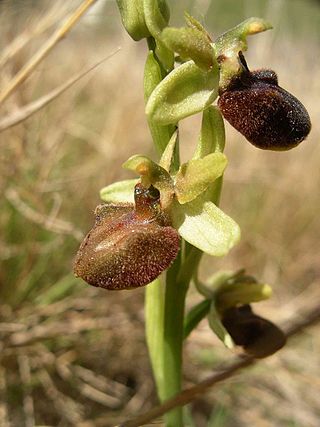
Ophrys sphegodes, commonly known as the early spider-orchid, is a species of sexually-deceptive orchid native to Europe and the Middle East. It is a very varied species with many subspecies recognised.

Epipactis palustris, the marsh helleborine, is a species of orchid native to Europe and Asia.
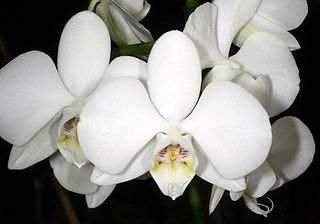
Phalaenopsis amabilis, commonly known as the moon orchid, moth orchid, or mariposa orchid, is a species of flowering plant in the orchid family Orchidaceae. It is widely cultivated as a decorative houseplant. It is an epiphytic or lithophytic herb with long, thick roots, between two and eight thick, fleshy leaves with their bases hiding the stem and nearly flat, white, long-lasting flowers on a branching flowering stem with up to ten flowers on each branch.
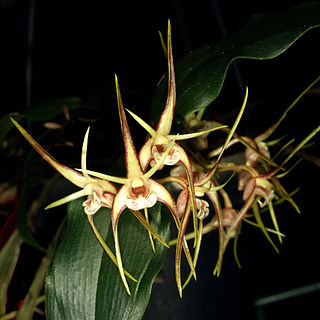
Dendrobium tetragonum, commonly known as the tree spider orchid, is a variable species of epiphytic or lithophytic orchid endemic to eastern Australia. Tree spider orchids are unusual in having pendulous pseudobulbs that are thin and wiry near the base then expand into a fleshy, four-sided upper section before tapering at the tip. There are only a few thin but leathery leaves at the end of the pseudobulbs and up to five flowers on relatively short flowering stems. To allow for the variations in the species there are five subspecies and a variety, some with a unique common name.
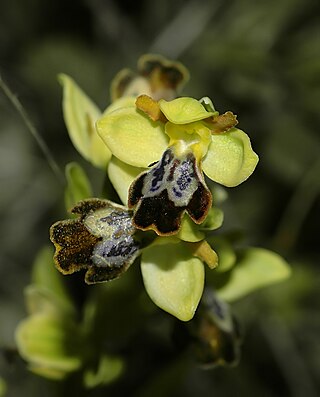
Ophrys fusca, commonly known as the sombre bee-orchid or the dark bee-orchid, is a species of orchid native to the Mediterranean from southwestern Europe and northern Africa to western Asia. Most subspecies of the Ophrys fusca are pollinated by males Andrena bees.

Ophrys omegaifera, the omega bee-orchid, is a species of orchid native to the Mediterranean region from Portugal and Morocco to Syria.

Ophrys umbilicata is a species of orchid found from Albania to Iran, including Greece, Israel, Lebanon, Turkey and Cyprus.
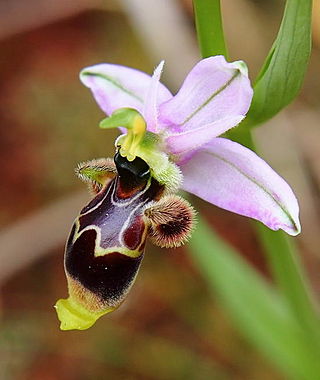
Ophrys scolopax, known as the woodcock bee-orchid or woodcock orchid, is a species of terrestrial orchid found around the Mediterranean and the Middle East, from Morocco and Portugal to Hungary and Iran.

Ophrys speculum, the mirror orchid, is a species of Ophrys distributed throughout the Mediterranean that is pollinated exclusively by a single species of scoliid wasp.

Ophrys sphegodes subsp. taurica, with many synonyms, including Ophrys caucasica, is a subspecies of orchid native from southeast Europe through the Caucasus to Iran. As Ophrys caucasica, it has been recorded in numerous areas throughout Armenia, Azerbaijan, Georgia and Russia. Local names include Armenian: Սարդակիր Մեղվակիր, romanized: Sardakir mexvakir, Azerbaijani: xarı-bülbül and Georgian: ფუტკრის-დედა, romanized:put'k'ris-deda.

Ophrys holosericea, the late spider orchid, is a species of flowering plant in the family Orchidaceae, native to western and central Europe and the Mediterranean region. There has been considerable confusion about the identity of this species and the correct spelling of its name.






















